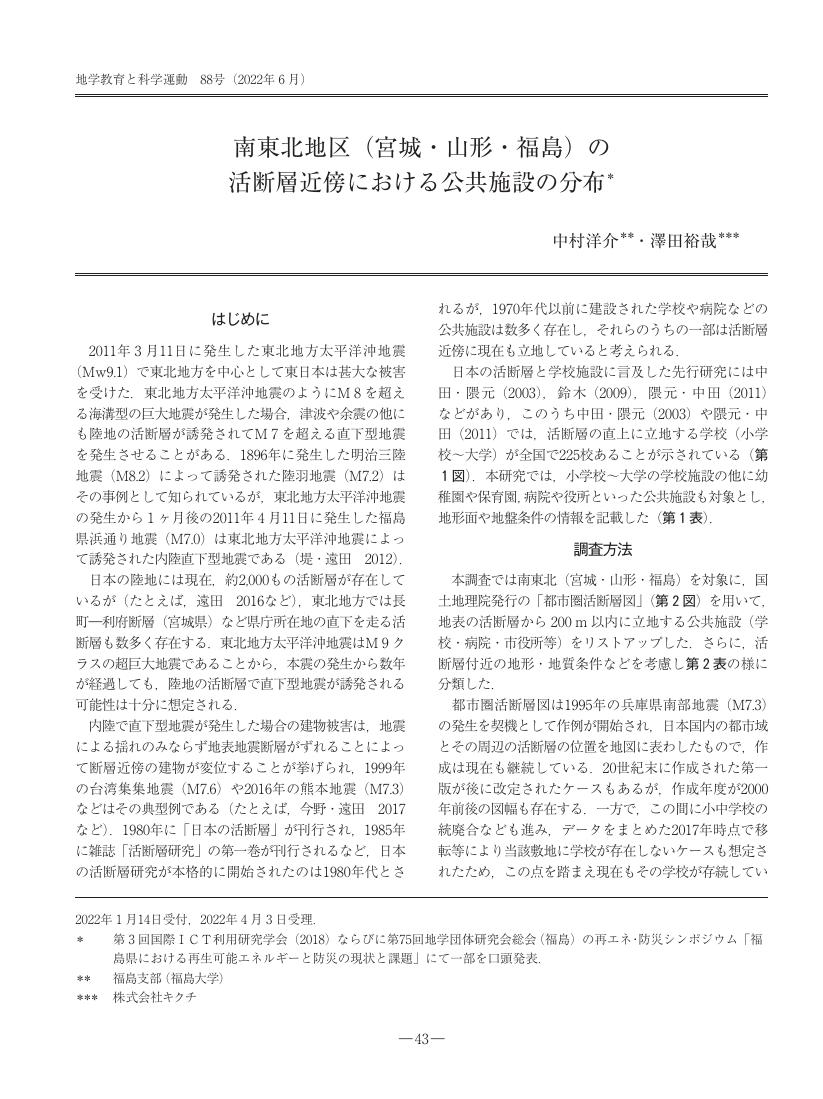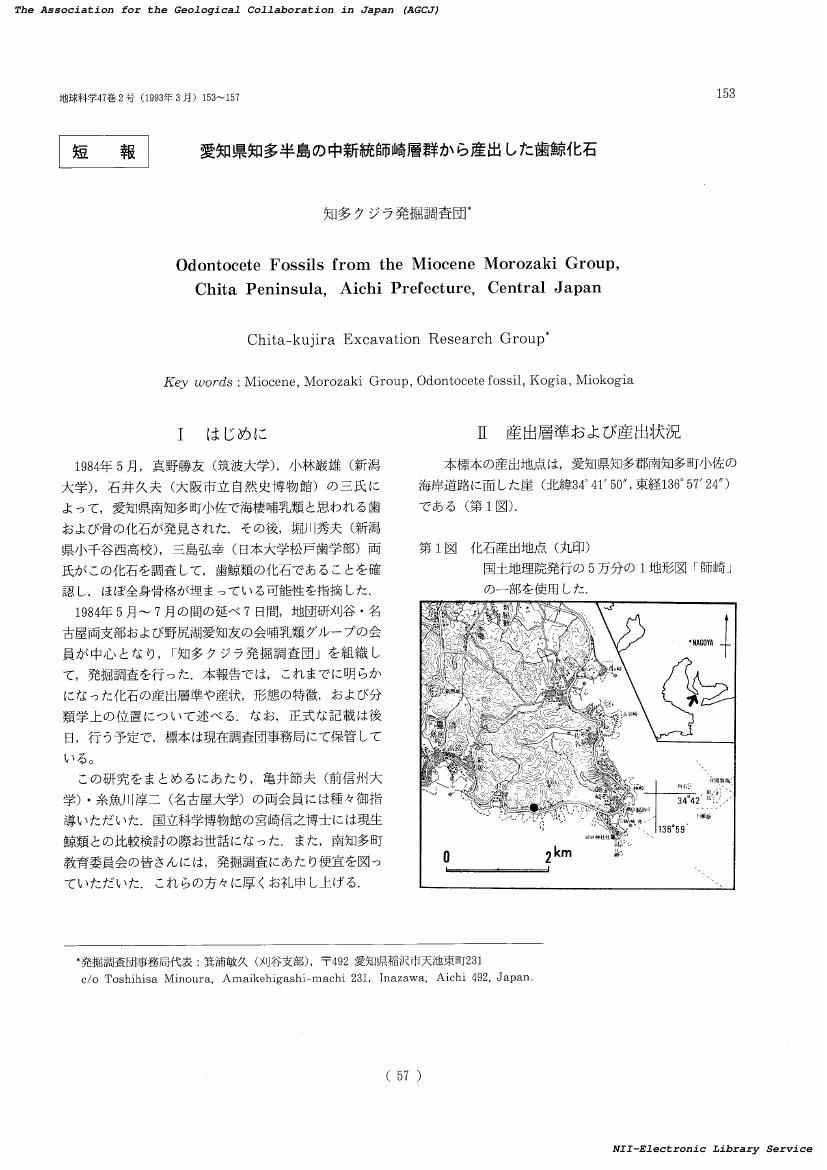- 著者
- 大森 昌衛
- 出版者
- 地学団体研究会
- 雑誌
- 地球科學 (ISSN:03666611)
- 巻号頁・発行日
- vol.61, no.1, pp.73-75, 2007-01-25
4 0 0 0 OA ジルコンの放射能効果(地学団体研究會創立十周年記念号)
- 著者
- 富田 達
- 出版者
- 地学団体研究会
- 雑誌
- 地球科学 (ISSN:03666611)
- 巻号頁・発行日
- vol.1956, no.26-27, pp.36-51, 1956-03-25 (Released:2017-07-24)
Many data on the radio-effects in zircon are examined with the following results: (1) Zircon is subdivided structurally into three groups : Group A-Non-metamict zircons, includimg normal zircon and transparent hyacinth (G>4.6 or 4.55); Group B-Partly metamict zircons (G=4.6-4.0); Group C-Completely metamict zircon or typical malacon (G=4.0-3.9 or less). (2) In the damage process in zircon are recongnized three stages: Stage I-a continuous change from normal zircon to transparent hyacinths up to a certain saturation of ionization by free elections, the degree of which is shown in the colour order: colourless-yellow-orange-pink-purple; Stage II-a biscontinuous change from Group A to Group B. This change involves the abrupt partaking of radiogenic dissociation (ZrSiO_4→ZrO_2+SiO_2) occurring in part within a single crystal. Megascopic translucency or nearly opaque character carrying with yellowish and/or greenish tinge is an indication of this change; StageIII- a continuous increase of the dissociation products in Group B. This stage ends with the formation of Group C, opaque and green or brownish-green. (3) Time has a becibebly greater effect than alpha-activity. Most of the post-Cambrian granite zircons do not show so wide a range of variation of 2θ as seen in the pre-Cambrian, and less damaged crystals are present among the Miocene zircons. (4) A series of zircon from the Middle Cretaceous granites in Japan exhibits the general tendency that the later members are of greater radioactivity. This may be a reflection of the evolution of granitic magma, which becomes more enriched in the radioelements in its later stages. (5) Radio-effects in zircon are gradually restored by heating. Naturally heated zircons are met with in granitic xenoliths often found within volcanic rocks. Colour of these zircons corresponds with the age of the volcanic rocks. This suggests a means of age-determination for volcanic rocks.
4 0 0 0 地学選択生徒はなぜ少ない?(花綵通信)
- 著者
- 森 伸一
- 出版者
- 地学団体研究会
- 雑誌
- 地学教育と科学運動 (ISSN:03893766)
- 巻号頁・発行日
- no.29, pp.76-77, 1998-04-25
4 0 0 0 「さざれ石」の由来と地質学的考察
- 著者
- 鈴木 博之
- 出版者
- 地学団体研究会
- 雑誌
- 地球科學 (ISSN:03666611)
- 巻号頁・発行日
- vol.57, no.4, pp.243-252, 2003-07-25
4 0 0 0 歴史資料を活用した古地震・歴史地震の研究(地球科学入門講座)
- 著者
- 小松原 琢 西山 昭仁
- 出版者
- 地学団体研究会
- 雑誌
- 地球科學 (ISSN:03666611)
- 巻号頁・発行日
- vol.60, no.3, pp.253-261, 2006-05-25
3 0 0 0 OA 南東北地区(宮城・山形・福島)の活断層近傍における公共施設の分布
3 0 0 0 OA 槇山次郎 ―貝類学・ナウマンゾウ・京都大学地質学鉱物学教室
- 著者
- 柴田 松太郎
- 出版者
- 地学団体研究会
- 雑誌
- 地学教育と科学運動 (ISSN:03893766)
- 巻号頁・発行日
- vol.37, pp.35-42, 2001-06-01 (Released:2018-03-29)
- 参考文献数
- 47
- 著者
- 山崎 静子 石賀 裕明 道前 香緒里 東 直子 Faruque Ahmed 三瓶 良和 Hamidur Rahman Badrul Islam
- 出版者
- 地学団体研究会
- 雑誌
- 地球科学 (ISSN:03666611)
- 巻号頁・発行日
- vol.54, no.2, pp.81-93, 2000-03-25 (Released:2017-07-14)
- 被引用文献数
- 3
1999年にバングラデシュのシャムタ村と東となりのデウリ村で18本のボーリングによって採集した堆積物試料(パーカッションリバースサーキュレーション工法による,一本の深さは約15m)をもちいて,地下水ヒ素汚染のメカニズムを解明するために,主元素,微量元素および全有機炭素,窒素,イオウの定量を行った.デウリ村の有機質泥ではAsが50ppmを超えるものがあり,ピート層では262ppmに達する.これらはシャムタ村の一般的な泥質試料(As=20ppm)に比べ高い値を示す.As濃度はVやCuの濃度と良い相関をもち,有機物の濃縮に関係する.P_2O_5も地表の試料で高いものがあり,人間活動に関連するといえる.試料のいくつかからはイオウが検出され,海成や汽水環境で堆積したことを示唆する.しかし,TS/TOC比は一般の海成層の値(0.36)よりも低く,淡水もしくは汽水環境で堆積した可能性がある.TOC/TN=9.2〜14.2(平均値11.1)であり,プランクトンおよび高等植物の両者に起源すると判断される.有機物に関連する高濃度のヒ素は帯水層での還元的環境下で地下水汚染を引き起こすと考えられる.農業や家庭排水の増加に伴って有機物の分解は促進され,堆積物,特にピート層からのヒ素溶出の速度を増していると考えられる.
3 0 0 0 OA 石炭産業と三井三池有明鉱火災事故(緊急レポート2)
- 著者
- 木戸 道男
- 出版者
- 地学団体研究会
- 雑誌
- 地学教育と科学運動 (ISSN:03893766)
- 巻号頁・発行日
- vol.13, pp.274-278, 1984-05-03 (Released:2018-03-29)
3 0 0 0 OA 愛知県知多半島の中新統師崎層群から産出した歯鯨化石
- 著者
- 知多クジラ発掘調査団
- 出版者
- 地学団体研究会
- 雑誌
- 地球科学 (ISSN:03666611)
- 巻号頁・発行日
- vol.47, no.2, pp.153-157, 1993-03-25 (Released:2017-06-06)
3 0 0 0 OA プトレマイオスのエカントとケプラーの法則の接点
- 著者
- 宮城 晴耕
- 出版者
- 地学団体研究会
- 雑誌
- 地学教育と科学運動 (ISSN:03893766)
- 巻号頁・発行日
- vol.77, pp.75-79, 2016-09-26 (Released:2020-06-02)
- 参考文献数
- 14
3 0 0 0 OA 新潟油田新津背斜の形成機構
- 著者
- 新津背斜団体研究グループ
- 出版者
- 地学団体研究会
- 雑誌
- 地球科学 (ISSN:03666611)
- 巻号頁・発行日
- vol.31, no.2, pp.70-82, 1977-03-25 (Released:2017-07-26)
- 被引用文献数
- 1
The Niitsu anticline, situated in the Niitsu hill, oil-field of Niigata, Japan, consists mostly of the middle Miocene to the Pliocene sediments with some volcanics, and is an asymmetrical fold with northwesterly dipping axial surface in the main part, and displays some irregular shape in the northern one. The trend of the anticlinal axis changes from NE-SW in the main part to N-S or NNE-SSW in the northern one drawing a curve, and it plunges at 10°-20° toward the north (Fig. 1). Most of the minor faults developed in the Neogene formations belong to the longitudinal fault system, where constituent faults have their strikes parallel to the fold axis. Orientations of principal stress axis can be determined by the conjugate fault sets of this system as follows: σ1 (maximum compressive principal stress) is nearly normal to the bedding, σ2 (intermediate principal stress) is nearly parallel to the anticlinal axis, and σ3 (minimum compressive principal stress) is parallel to the bedding and normal to the anticlinal axis (Fig. 6). These represent the stress field in the past, that is at the faulting of this system. It is remarkable fact that these directional relationship between the principal stress axes and the fold axis is consistently maintained even if the trend of fold axis changes from NE-SW to N-S as in the northern part. Such a close relation strongly suggests that these faults and the Niitsu anticline might be formed under the same tectonic field of stress. In the Pleistocene formation unconformably orerlying the Neogene strata, some conjugate sets of minor fault with strikes normal to the fold axis are developed to compose the transversal fault saystem. Based on them, orientations of principal stress axes at the faulting of this system are restored as follows: σ1 is vertical, σ2 and σ3 are both flat, and nearly normal and parallel to the elongation of the Niitsu hill respectively (Fig. 5). It is noteworthy that these orientations are fixed through the whole region surveyed independent on the turning of the fold axis. This reveals that the stress field at the faulting of this system is different from that at folding, and it might correspond with that of the later stage, namely at the general upheaval of the Niitsu hill. With respect to the genetical type of fold, the Niitsu anticline is intensely suggested to be of transversal bending through discusions about the stress field expected by the fold of buckling or longitudinal bending and of the transversal bending as well as the effect of the movement of basement block on the overlying strata. From the above mentioned morphological characteristics and dynamic structures clarified in the Niitsu anticline, it is reasonably concluded at present that an uplifting with some tilting of the basement block is most adequate as a model for the mechanism of folding. Judging from the arrangement and orientations of fold axes around the Niitsu anticline, especially those in its northern and southern extension, differently oriented two types of basement blocks are supposed to exist beneath the Neogene strata; one is arranged in nearly NE-SW direction and the other is in N-S. Problems about the causes of such a blocking and its later uplifting with tilting are remained for future research.
3 0 0 0 「温暖化懐疑論」をどう考えるか
- 著者
- 増田 善信
- 出版者
- 地学団体研究会
- 雑誌
- 地学教育と科学運動 (ISSN:03893766)
- 巻号頁・発行日
- no.70, pp.29-42, 2013-07-25
3 0 0 0 OA 青森県尾太鉱山跡地の廃水中から発見されたマンガン団塊
- 著者
- 山本 玄珠 長峰 崇 北垣 俊明 海野 友紀
- 出版者
- 地学団体研究会
- 雑誌
- 地球科学 (ISSN:03666611)
- 巻号頁・発行日
- vol.58, no.6, pp.375-388, 2004-11-25 (Released:2017-07-14)
筆者らは,青森県尾太鉱山跡地坑道内において,廃水性マンガン団塊を発見した.本マンガン団塊は,15年以内で形成されたものである.粗粒から中礫サイズのこのマンガン団塊は,ブドウ状表面構造を有すマンガンクラスとともに産出するが,それらは微生物のマットと思われる物質が広く発達している中に認められる.いくつかのマンガン団塊のコアや表面には微生物と思われる物質が含まれていた.今回発見されたマンガン団塊は全て球状を呈し、層構造を有すが,それらは深海のマンガン団塊の形状(Meylan 1974)で示すとs-m[SDP]sまたはs-m[SDP]s+rに分類される.本マンガン団塊が微生物的物質と共に存在することから,本マンガン団塊の形成には,微生物的物質が関係していると考えられる.
3 0 0 0 OA 澄江生物群(用語解説)
- 著者
- 大森 昌衛
- 出版者
- 地学団体研究会
- 雑誌
- 地球科学 (ISSN:03666611)
- 巻号頁・発行日
- vol.52, no.2, pp.160-161, 1998-03-25 (Released:2017-07-11)
- 著者
- 鈴木 明彦 圓谷 昂史
- 出版者
- 地学団体研究会
- 雑誌
- 地球科学 = Earth science (ISSN:03666611)
- 巻号頁・発行日
- vol.73, no.2, pp.103-110, 2019-04
3 0 0 0 丹波帯南西部の"非丹波層群"の砂岩 : モード解析とその比較
- 著者
- 楠 利夫 武蔵野 実
- 出版者
- 地学団体研究会
- 雑誌
- 地球科學 (ISSN:03666611)
- 巻号頁・発行日
- vol.45, no.1, pp.39-50, 1991-01-25
- 被引用文献数
- 6
Four formations named Ajima, Yamashita, Nagaoyama and Takatsuki, are extensively distributed in the southwestern part of the Tamba Belt and have been regarded as parts of the Tamba Group. Those are mainly composed of clastic sediments such as alternating sandstone and shale, and black shale. Detrital modes of their sandstone are rich in acidic to intermediate volcanic rock fragments, plagioclase, and poor in quartz. Multivariate analyses including regression analysis and cluster analysis reveal that these sandstones are very similar to those of the upper Permian Oi Formation in the Ultra-Tamba Zone. Those formations are differentiated them from the Tamba Group (the Type I and the Type II suites) and named the "Non-Tamba Group" b formation. Furthermore, this b formation lies on the equivalent strata of the Hikami formation, and both of them are separated the Tamba Group by fault. Incidentally, there is a little difference between the facies of the Oi Formation and that of the "Non-Tamba Group" b formation. The Oi formation is an accretionary complex in the subduction zone, On the contraly, it is concluded that the "Non-Tamba Group" b formation deposited on a forearc basin during late Permian to early Triassic time.
- 著者
- カビール ファッツル 高須 晃
- 出版者
- 地学団体研究会
- 雑誌
- 地球科学 (ISSN:03666611)
- 巻号頁・発行日
- vol.64, no.5, pp.183-192, 2010
- 参考文献数
- 34
四国中央部別子地域に分布するエクロジャイト質塩基性片岩には2回の独立した変成作用イベントが記録されている.すなわち,1回目のエクロジャイト変成作用イベントと2回目の藍閃石-バロワ閃石変成作用イベントである.エクロジャイト変成作用イベントのピーク変成作用は,エクロジャイト相の片理を形成する鉱物組み合わせ(ざくろ石,オンファス輝石,バロワ閃石,フェンジャイト,ルチル,石英)によって示される.この変成条件は,これまでの研究から610-640℃,12-14kbarと推定されている.ピーク変成作用の後,減圧を伴う降温期変成作用により緑れん石角閃岩相の条件(400-535℃,6-7kbar)となった.この変成条件は,エクロジャイト変成作用イベントのピーク変成作用を示す鉱物を置換する鉱物組み合わせにより示される.藍閃石-バロワ閃石変成作用イベントは,エクロジャイト相の鉱物組み合わせからなる片理を切って成長する顕著な累帯構造を示す角閃石の化学組成の変化から,緑れん石青色片岩相から緑れん石角閃岩相に至る昇温期の変成経路が復元できる.この変成作用は,エクロジャイト岩体周囲の三波川結晶片岩の昇温期変成作用と類似する.これらのことより,瀬場エクロジャイト質塩基性片岩は,エクロジャイト相のピーク変成作用の後,少なくとも藍閃石の安定な低温の変成条件の下で三波川結晶片岩と接合し,ともに昇温期変成作用を受けて緑れん石角閃岩相に達し,その後,現在の地表レベルにまで上昇したと考えられる.
3 0 0 0 練馬大根をテーマに地学通信 : 「練高地学散歩」の発行
- 著者
- 佐瀬 和義
- 出版者
- 地学団体研究会
- 雑誌
- 地学教育と科学運動 (ISSN:03893766)
- 巻号頁・発行日
- no.66, pp.59-65, 2011-11-18






